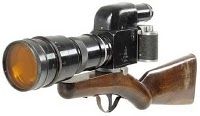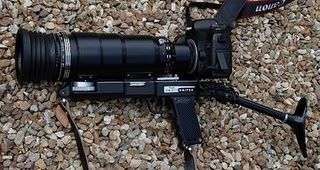
Blog archives

Wednesday, July 23, 2008
Photosniper
Do you know the Photosniper?This strange instrument is composed of a fast focus telephoto lens (4.5/300mm), fitted on a special version of Zenit camera, the whole attached on a rifle butt. But the Photosniper existed long before the birth of the Zenit. The FS2, intended for the army, was designed by the State Institute for Optics (GOI) in Leningrad: on a wooden rifle butt is attached a set composed of a FED camera, a reflex housing and a telephoto lens GOI 4.5/300mm; the trigger controls at the same time the rise of the reflex housing mirror and the shutter release. Production was taken over by KMZ in 1944-1945.

Until today no FS(1) is known. The model using Zenit ES is called FS3. The lens, Tair 3, dates from 1956 in its "normal" version, it is an evolution of the "GOI" one. It was awarded, among a lot of Soviet design lenses, a "grand prix" at the World Exhibition in Brussels in 1958. The first Zenit "E" (39mm screw mount, non-automatic mirror) came out in 1965, J.L.Princelle gives the same year for the launching of FS3, with Zenit ES and modified Tair with fast-focusing knob (Tair3 AS or FS, or PhS, the name varies depending on the series). The photosniper was later produced with different camera bodies; from FS12 (with Zenit 12) was added an electrical connection between the lens and the body, allowing full-aperture light-metering.see: My Zenit ESand: The Photosniper.Sources:The authentic guide to Russian and Soviet cameras, J.L.Princelle, Le Rêve Editions.(†)www.zenitcamera.com
DIY page: Photosniper for Canon EOS

With the acquisition of Praktica B200 came to me the idea of modifying the photosniper, replacing the "finger" which controls the shutter release through the Zenit baseplate with a release cable. The B200 is well suited to this type of assembly because the body is small enough to leave room for the passage of the cable under its base, it should also work with a small Pentax (ME, MX...), a Minolta X300... More, my release cable was an adjustable version, suitable for different cameras.Now I take my photos with a Canon Eos digital camera, on which I can fit almost all my lenses, using rings found on eBay. But with these bodies, you no longer use a cable release, the control is electric! So I modified again the photosniper butt, still without drilling any holes or modifying any part, It must be possible to return it to its original state!Supplies:-a Photosniper,-a Canon Eos digital camera,-an adapter ring M42->Canon Eos, provided with an "AF confirm chip"(*),-a headset for mobile phone with 2.5mm jack,-an out of order home DVD player(!)-and for Eos 40D, 5D, a cheap remote control and a female 2.5 jack connector, for the remote adapter.-Photos and details on this page.Little further refinement: A Canon EP-EX15 eyepiece extension (twenty euros) (useful for eyeglass wearers) to look like the eyepiece of Zenit ES.* It is important to get Canon atapter rings equipped with an "AF confirm chip": the camera sees an AF lens in manual mode, and activates the autofocus assist mode with a beep and the illumination of an AF sensor once focus found. Then it allows to be sure that the camera will correctly do the light metering. I even have a provider who programs the "chip" depending on the lens, the images will show in their exif data that the lens is a 4.5/300mm!Caution when using the Canon Eos Photosniper: after focusing, then closing the diaphragm by pressing the trigger half way, release the trigger before pressing it again, to prevent the camera from exposing for a light quantity memorized at full aperture. It wastes time? work with diaphragm already closed, it will more prevent the clack when closing to make escape your "client".